
-
Find the right food for your pet
Take this quiz to see which food may be the best for your furry friend.
Find the right food for your pet
Take this quiz to see which food may be the best for your furry friend.
Featured products
 Adult Healthy Cuisine Roasted Chicken, Carrots & Spinach Stew Dog Food
Adult Healthy Cuisine Roasted Chicken, Carrots & Spinach Stew Dog FoodDelicious roasted chicken paired with tender vegetables in a succulent stew
Shop Now Small & Mini Savory Stew with Chicken & Vegetables Dog Food
Small & Mini Savory Stew with Chicken & Vegetables Dog FoodA delicious complement to the nutrition of Science Diet Small & Mini 7+ dog food
Shop Now Adult 7+ Perfect Digestion Chicken, Whole Oats & Brown Rice Recipe Dog Food
Adult 7+ Perfect Digestion Chicken, Whole Oats & Brown Rice Recipe Dog FoodScience Diet's breakthrough nutrition supports ultimate digestive well-being & healthy microbiome for dogs age 7+
Shop NowFeatured products
 Adult 7+ Tender Tuna Dinner Cat Food
Adult 7+ Tender Tuna Dinner Cat FoodWith delicious chunks in a decadent gravy
Shop Now Adult Savory Entrée Can Variety Pack Cat Food
Adult Savory Entrée Can Variety Pack Cat FoodPrecisely balanced nutrition with the delicious taste of savory minced chicken to help fuel the energy needs of cats during the prime of their life
Shop Now Adult 7+ Senior Vitality Chicken & Vegetable Stew Cat Food
Adult 7+ Senior Vitality Chicken & Vegetable Stew Cat FoodImproves Everyday Ability to Get Up & Go
Shop Now -
Dog
- Dog Tips & Articles
-
Health Category
- Weight
- Food & Environmental Sensitivities
- Urinary
- Digestive
- Joint
- Kidney
-
Life Stage
- Puppy Nutrition
- Adult Nutrition
- Senior Nutrition
Cat
- Cat Tips & Articles
-
Health Category
- Weight
- Skin & Food Sensitivities
- Urinary
- Digestive
- Kidney
-
Life Stage
- Kitten Nutrition
- Adult Nutrition
Featured articles
 Does My Pet Hate Me?
Does My Pet Hate Me?Learn tips for bonding with your pet if you've ever thought, 'My dog doesn't like me, or 'Why do I have a standoffish cat?'
Read More Why Are Dogs and Cats So Cute?
Why Are Dogs and Cats So Cute?If waggy puppy dog tails and furry kitten yawns make you swoon, you're not alone. Why are cats so cute? And, dogs too! Let's find out!
Read More Do Dogs and Cats have Belly Buttons?
Do Dogs and Cats have Belly Buttons?Learn whether cats & dogs have belly buttons like humans, what the function is, and if there are any health concerns associated with it.
Read More -


Despite their reputation as fastidious groomers, cats are susceptible to a variety of skin conditions. Cat skin disease can result from infectious causes, such as skin mites; allergies, such as flea allergy dermatitis; or more obscure conditions, such as psychogenic alopecia.
While skin conditions in cats can range from straightforward to complex, they tend to have one thing in common: They can be a chronic source of discomfort for both cat and cat parent.
Risk Factors for Skin Conditions in Cats
Kittens' immune systems take time to develop, making them more vulnerable to common infectious causes of skin disease, such as ringworm or mites. As your kitten grows into adulthood, they may develop allergies, which can lead to dermatitis (inflamed, irritated skin) or a more advanced allergic condition called eosinophilic granuloma complex (a pattern of skin reactions associated with specific lesions). Cats of all ages can also experience skin conditions in response to environmental stressors, such as changes in household members.
Infections, allergies and environmental stressors can all weaken the integrity of your cat's skin — their largest organ — and make it more susceptible to illness or disease.
Generally speaking, young cats, senior cats and outdoor cats are at higher risk for developing skin conditions. Hormones associated with intact (not neutered) male cats are also linked to some skin conditions, and certain breeds are more likely to develop skin diseases that share a genetic link.
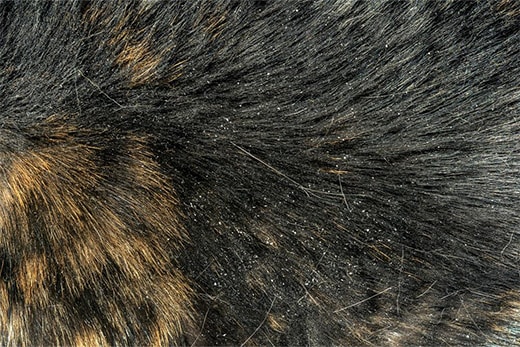
Signs of Skin Conditions in Cats
You may notice changes in your cat's skin or fur during routine petting at home. Here are some signs of cat skin issues to look out for:
- Flaky skin (dandruff)
- Greasy skin
- Hair loss (alopecia)
- Sores, bumps or growths
- Scabbing
- Inflamed or thick patches of skin
- A dirty-looking chin (like it has specks of dirt on it)
- Red bumps or ulcers on the lips
- A dark substance in the ears accompanied by head shaking or scratching
- Scratching or biting at the skin
If you notice any of these signs, consult your veterinarian for advice. They can help you identify the cause of your cat's skin problems and suggest a treatment plan.
Common Cat Skin Diseases
While your veterinarian will provide a diagnosis (likely after running some tests), here is some information about the more common skin conditions in cats so you can stay informed. Keep in mind that this list isn't comprehensive. Again, any skin lump, bump, or texture or color abnormality warrants a veterinarian's attention.
Flea Allergy
Fleas can irritate all cats, but cats who are allergic to flea saliva are highly sensitive to flea bites. If your cat has a flea allergy, a single bite can trigger a reaction, leading to skin infections (red, oozing lesions), dermatitis (raised, itchy bumps) and hair loss. Cats with flea allergies often bite, chew and scratch themselves compulsively, particularly at the base of the tail and around the neck.
Feline Acne
If your cat's chin suddenly looks dirty or if you notice red bumps on their chin or lips, feline acne might be to blame. Feline acne isn't typically a serious condition, but it still warrants a veterinarian's medical attention. Using medicated grooming pads or gels and making simple lifestyle changes, such as switching to stainless steel dishes or cleaning feeding dishes more frequently, can help alleviate breakouts. For more severe cases, your veterinarian may prescribe oral or topical antibiotics.
Superficial Pyoderma
Superficial pyoderma is an umbrella term for a skin infection that affects the skin's top layer. It can have many causes and is often a secondary infection. Common signs include hair loss and red, moist, tender, scaly or itchy skin. If this condition progresses, it can spread to the skin's deeper layers, referred to as "deep pyoderma." Consult with your veterinarian to identify the best treatment and possible prevention.


Tasty Tips
Ear Mites and Skin Mites
Ear mites are highly contagious and especially common in outdoor cats and kittens. Your cat may frequently scratch or shake their head. Ear mite infestations also often cause a gooey, dark brown or black substance in the ears. If you suspect your cat has ear mites, call your veterinarian right away.
Skin mites occur all over the body and can result in hair loss, red or bumpy skin lesions and excessive scratching. Simple, effective treatment can relieve discomfort and prevent skin or ear infections and damage.
Abscesses and Tumors
This category of skin conditions is broad — and so is the range of its signs and appearance. If you notice any new swelling or bump on your cat's skin, schedule an appointment with your veterinarian so they can dig further into the cause.
Psychogenic Alopecia
If your cat has patches of fur missing and sores on their body, particularly in areas within their reach, this may point to a behavioral concern known as psychogenic alopecia. Cats who are prone to stress may groom themselves compulsively, leading to thinning hair and, ultimately, skin infections. Talk to your veterinarian about solutions to help alleviate stress in your cat's environment.
Flaky or Greasy Skin
In some cases, flaky or greasy skin can indicate that your cat needs some grooming help. Obese cats often have an especially hard time reaching their lower back and the base of the tail. These signs can also signal other underlying medical concerns, such as hormonal dysfunction or diabetes.
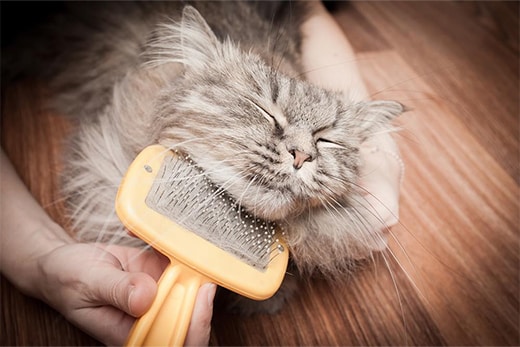
How to Support Healthy Skin and Prevent Skin Infections in Cats
Fortunately, you can take steps to help your cat maintain healthy skin and a lustrous coat.
At-Home Grooming
Your cat's tongue is covered in tiny, self-grooming tools called papillae, and they do their job well. Still, this is no excuse to neglect grooming your cat. Brushing your cat removes dirt, oil and loose hair (which can decrease the risk of hairballs), and it's the perfect opportunity to give your cat's skin a wellness check. Short-haired cats do well with brushing once or twice a week while long-haired cats can benefit from daily grooming to prevent tangles and matting. Make the experience pleasant for both you and your cat by choosing brushes and grooming tools they enjoy.
Balanced Nutrition
Feeding your cat a healthy, balanced food is key to maintaining healthy skin. Vitamins such as A, E and D, omega-6 fatty acids and amino acids are all critical to maintaining skin health at the cellular level.
Regular Checkups
Attending your cat's regularly scheduled veterinarian visits can help get ahead of any issues. They're also a great opportunity to discuss any concerns or ask about changes in your cat's grooming habits. Of course, if you notice any signs of skin disease or illness, schedule a veterinary visit right away. The sooner your veterinarian can address the issue, the sooner your cat will feel better.
Protecting Your Cat's Well-Being
Even if your cat is a great self-groomer, check their fur and skin for any possible concerns during your daily snuggle sessions. By keeping an eye out for any changes, providing quality, science-backed nutrition and helping out with grooming now and then, you can give your cat the best of the best — which is what they deserve.


Dr. Laci Schaible is a small animal veterinarian, veterinary journalist, and a thought leader in the industry. She received her Doctor of Veterinary Medicine from Texas A&M University and her Masters in Legal Studies from Wake Forest University.
Related products

With delicious chunks in a decadent gravy

Supports energy level and beautiful fur in mature cats

Improves Everyday Ability to Get Up & Go

Precisely balanced nutrition with the delicious taste of savory minced chicken to help fuel the energy needs of cats during the prime of their life
Related articles
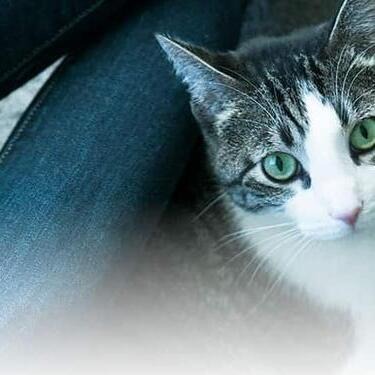
Brushing your cat's teeth is just as important as brushing your own. Learn signs or oral health problems in your cat and how to avoid them.
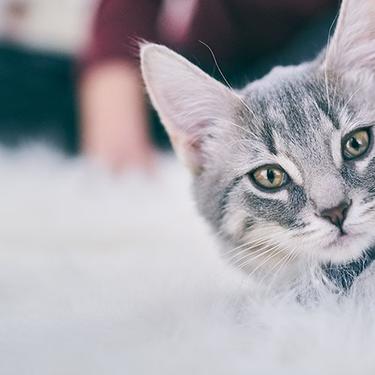
Discover the benefits of Hill's line of kitten foods and how they provide complete and balance nutrition for growing kittens.
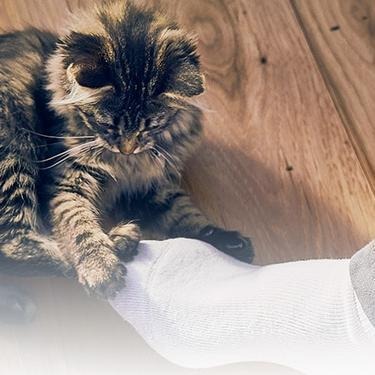
Discover which cat toys games your feline friend might like, and how they are great sources of exercise. Explore our library of articles to learn more.
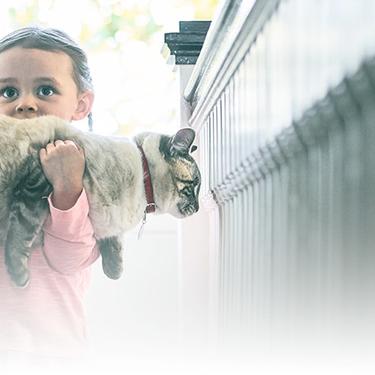
Discover how to identify cat sensitive skin and what you can do to help your cat thrive from head to paw.

Put your cat on a diet without them knowing
Our low calorie formula helps you control your cat's weight. It's packed with high-quality protein for building lean muscles, and made with purposeful ingredients for a flavorful, nutritious meal. Clinically proven antioxidants, Vitamin C+E, help promote a healthy immune system.
Put your cat on a diet without them knowing
Our low calorie formula helps you control your cat's weight. It's packed with high-quality protein for building lean muscles, and made with purposeful ingredients for a flavorful, nutritious meal. Clinically proven antioxidants, Vitamin C+E, help promote a healthy immune system.

